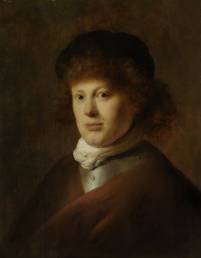Current and recent projects
Constantijn Huygens
Translation of Constantijn Huygens Memoirs of a Renaissance Childhood and Youth (full edition in progress)
An excerpt from Huygens on Rembrandt and Lievens (1631), translated from the Latin by J.A. Deitch.
Only an excerpt from Huygens’s discussion of Rembrandt is currently available in English translation and it conceals the fact that this is a ‘parallel life’ comparing two great Dutch Golden Age painters, Rembrandt and Lievens. It is his portrait of the young Rembrandt you see here.
Rembrandt and Lievens
In this file-past I have deliberately kept in reserve a pair of noble young painters from Leiden. Even if I say they are the only ones who can equal those great artists I have already praised as the wonders of mortal men, I would still be selling them short. And if I say that it won’t be long before they surpass the ones whom I have already designated as men of genius, then I wouldn’t be adding anything to the expectations of the most distinguished authorities based on their extraordinary debut. Moreover, if I consider the nativity of these two then I find the strongest argument that nobility of blood does not exist. Of course there are people who swear by nobility of blood alone, but I remember how wittily the champions of this standpoint were cut down to size by the Italian satirist Traiano Boccalini, a modern author who writes in a very elegant and pure style. In a story about the anatomical dissection of the body of a nobleman he has the attending physicians, after a careful examination of the man’s veins, conclude unanimously that nobility is not to be found in the blood, since they could find no difference between this man’s blood and that of a commoner or peasant.
Of my two young friends, the one was the son of a common tailor, a man who “painted with his needle”; the other the son of a miller, although certainly not made from the same dough as his father. Who would not be struck dumb if he were to see two ingenious and talented marvels of this kind springing up from the ploughing of such a furrow? When I inquire about the schoolmasters who taught them when they were boys I find that they are men who have hardly made a name outside the common orders; on account of their parents’ slender means these boys were obviously assigned the kind of teaching masters who come at a cheap rate. Yet if these teachers were now brought face to face with their former pupils they would blush with shame—the same shame, I believe, as the teachers must have felt who first instructed Virgil in the art of poetry, Cicero in rhetoric, and Archimedes in mathematics. But while giving each his due and without insulting anyone (why would I want to do that?), I say that these two owe nothing to their teachers and everything to their own genius. Even if they had never had anyone leading the way, but had been left to themselves for a long while and then been gripped quite accidentally one day by the compulsion to paint, I am convinced that they would have achieved the same high level of accomplishment that they have now. It is entirely false to believe that they have risen so high because they have been led by the hand.
© Translation Judith Deitch
Flower Still Lifes
Translation of Dutch and Flemish Flower Pieces: Paintings, Drawings and Print up to the Nineteenth Century, translated by Judith Deitch (Leiden: Brill, 2020) brill.com/display/title/34060
Aids for Translating Art Texts
Wallraf-Richartz Museum website on painting techniques www.maltechnik-wallraf.de/en
